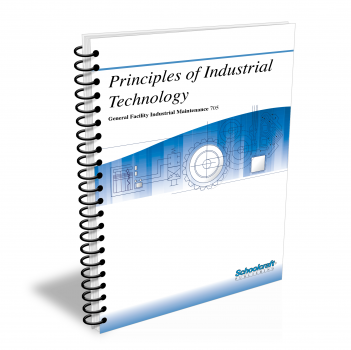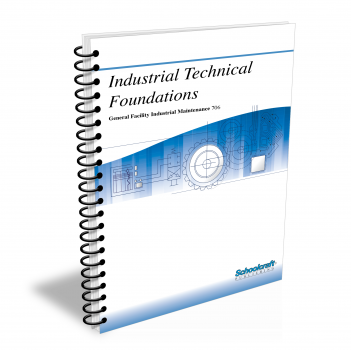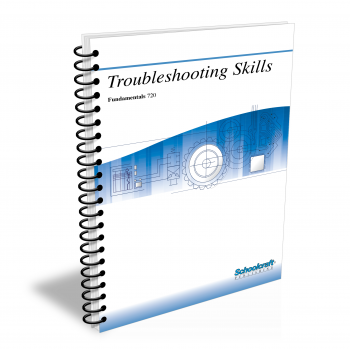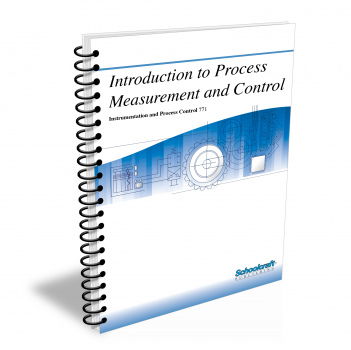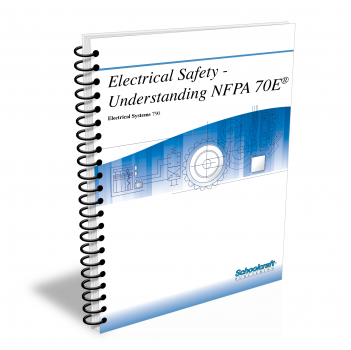Industrial Safety and Health
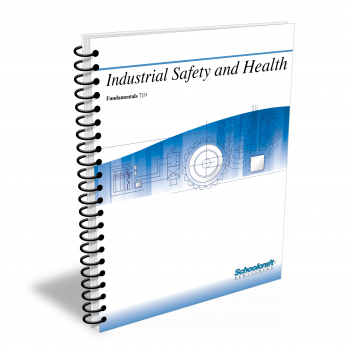
Course Number: 719
The Industrial Safety and Health textbook is the cornerstone of preparation for working in industry. The focus throughout is on principles that can be applied in many kinds of circumstances to ensure the personal safety of oneself and others. Chapter Two covers the requirements of OSHA and other government agencies. Other chapters deal with both physical safety and the protection of health. Also includes the Globally Harmonized System (GHS) of chemical classification and labeling. This textbook is an excellent introduction to specific company safety programs that may follow immediately or in the future.
Does your curriculum require additional topics not included in this textbook? Build a customized version of the Industrial Safety and Health textbook below.
This textbook has been recently updated
to include topics lists, objectives, & key terms for every chapter.
Recommended Contact Hours – 18
Preview a Chapter
Available Supporting Material
- Table of Contents
- Exam Copies
- Suggested Titles
Table of Contents
Chapter 1: Introduction to Safety
Topics: Responsibility for safety; Unsafe acts and conditions; Recognizing hazards; Types of accidents; Investigation; Handling emergencies
Learning Objectives:
- Define the terms accident and hazard.
- Name and define the four main types of hazards.
- List and define various types of accidents.
- Compare meanings of the terms unsafe act and unsafe condition.
- Name the three ways in which a toxic substance can enter your body.
- List ways in which a company must plan for emergencies.
- Tell the main reason for prompt accident investigation.
Chapter 2: Safety Laws
Topics: OSHA standards and inspections; Records and reports; Hazard communication; SDS, NIOSH, EPA
Learning Objectives:
- State the purpose of the OSHA Act.
- List the specific rights of employees under the Act.
- Explain what to do in a dangerous work situation.
- List things that you can do to help keep your workplace in compliance with OSHA standards.
- Explain the function of each of the following agencies: NIOSH, EPA.
- List the four main objectives of OSHA's Hazard Communication Standard.
- Tell what information can be found on an SDS.
Chapter 3: Personal Protective Equipment
Topics: Work clothes; Gloves; Head, eye, face, hearing and foot protection; Safety harness and lifeline; Respiratory protection
Learning Objectives:
- List employer and employee responsibilities related to PPE.
- Tell why work clothing can be dangerous if it fits poorly.
- Explain the importance of proper glove selection when handling chemicals.
- Describe the proper fit of a hard hat.
- Compare and contrast everyday eyeglasses, industrial safety glasses, and safety goggles.
- Identify the noise level at which you must wear hearing protection.
- Name the two basic kinds of respirators.
Chapter 4: Chemical Safety
Topics: Physical and health hazards; Exposure routes; Control of hazards and exposures; Chemical spill response; First aid
Learning Objectives:
- Define the terms chemical hazard, physical hazard, and health hazard.
- Name three kinds of physical hazards.
- Name and describe at least four kinds of health hazards.
- Identify common symptoms of chemical exposure.
- List three health hazard exposure routes.
- Name three ways of controlling chemical hazards and exposures.
- Explain first aid procedures to follow when you are exposed to a hazardous chemical.
Chapter 5: Tool Safety
Topics: Screwdrivers; Wrenches; Pliers; Hammers and mallets; Chisels and punches; Knives; Electric tools; Pneumatic and gas-powered tools
Learning Objectives:
- Name at least three causes of hand tool accidents.
- List one safety rule to follow when using each of the following: screwdriver, wrench, pliers, hammer, chisel, knife.
- Describe proper and improper dress for working with rotating power tools.
- Explain the importance of grounding electric tools.
- Name two hazards involved in pneumatic tool use and explain how to guard against them.
- Explain proper handling and storage of gasoline.
Chapter 6: Safe Materials Handling
Topics: Rules for lifting; Handling various shapes and sizes; Industrial hand trucks; Powered trucks; Dock safety; Conveyors; Hoists and cranes
Learning Objectives:
- List simple safety procedures and precautions related to material handling.
- Describe how to lift, carry, and put down a load.
- Explain safety principles for working with or around industrial trucks.
- Discuss safety rules for working with or around conveyors, slings, and hoists.
- Describe how and where to store materials.
Chapter 7: Machine Safety
Topics: Safety guards; Other safety devices; OSHA lockout/tagout procedures
Learning Objectives:
- Identify a machine's point of operation and other pinch points, and explain why they are dangerous.
- Identify different kinds of mechanical safeguards, and explain why they are necessary.
- Define zero energy state.
- Describe the lockout/tagout procedures established by the OSHA energy control standard.
Chapter 8: Electrical Safety
Topics: Electric circuit; Injuries from electricity; First aid for shock victims; National Electrical Code; Static electricity
Learning Objectives:
- Define the following terms: electric current, circuit, potential difference, ampere, watt, ohm, and volt.
- State Ohm's Law.
- Explain the function of each wire in a simple electric circuit and tell the color(s) used to identify each.
- List the three factors that affect the severity of an electric shock.
- Describe the effects of electric current on the human body.
- Tell the three most important points about first aid for shock victims.
- Explain how static electricity is generated, why its accumulation can be dangerous, and how it can be avoided.
Chapter 9: Electrical Protection
Topics: Grounding; Ground faults; Fuses and circuit breakers; Double-insulated tools; Hazardous electrical locations; Basic safety rules
Learning Objectives:
- Explain the importance of proper grounding.
- Define the term "ground fault" and explain how ground faults occur.
- Explain the purpose and operation of the following devices: GFCI, fuse, circuit breaker.
- Identify typical hazardous electrical locations.
- Explain the purpose of explosion-proof and intrinsically safe electrical equipment.
- List at least two electrical safety rules in each of the following areas: clothing, equipment, water, lockout/tagout.
Chapter 10: Fire Protection
Topics: How fires start; Classes of fire; Fire and explosion hazards and prevention; Fire-fighting substances; Fire hoses and extinguishers
Learning Objectives:
- List and explain the four elements of the fire pyramid.
- Name and give the definition of the four classes of fires.
- Define the terms flash point and spontaneous combustion.
- Name the fire-fighting agents, and explain how they work and when to use them.
- Explain the use of at least two different types of portable fire extinguishers.
- List three ways of preventing fires.
- Explain fire hose and fire extinguisher maintenance.
Chapter 11: Health Protection
Topics: Ergonomics; Noise; Radiation; Asbestos and lung disease; Fetal protection; The environment
Learning Objectives:
- Define ergonomics and tell how poor ergonomic conditions affect the body.
- List three actions that you can take to protect your hearing.
- Tell the cause of each of the following lung diseases: asbestosis, lung cancer, brown lung, black lung, silicosis.
- Contrast ionizing and nonionizing radiation.
- Compare and contrast personal and background sampling.
- Explain the importance of protecting women from exposure to certain chemicals.
- State the purpose of the EPA.
Chapter 12: Safe Work Practices
Topics: Housekeeping; Walking and working surfaces; Safety in traffic and at elevations; Ladders and scaffolds; Lighting; Safety in extreme heat; Confined spaces; Welding and cutting
Learning Objectives:
- Explain the importance of industrial housekeeping.
- List safety measures related to walkways, stairs, and floor openings.
- Tell how to protect yourself and others when working in traffic paths.
- Describe at least three hazards involved with each of the following and tell how to safeguard against them: working at elevations and working in confined spaces.
- Calculate the proper placement of a straight ladder based on its working length.
- Name two kinds of scaffolds and give at least one safety rule associated with each.
- List symptoms of heatstroke, heat cramps, and heat exhaustion.
- Name two major safeguards necessary when welding.
- Explain how to handle and store cylinders safely.
Request Exam Copies
Exam Copies
Ready to see a copy of our textbooks? After selecting which textbooks you’d like to review for your course, you can submit your request by either logging in or creating an account so we know where to ship your exam copies. A representative from Schoolcraft will contact you to confirm and finish processing your request.
Exam copies are always free and yours to keep.
Selected Exam Copies
none selected
* Maximum of five copies can be ordered
